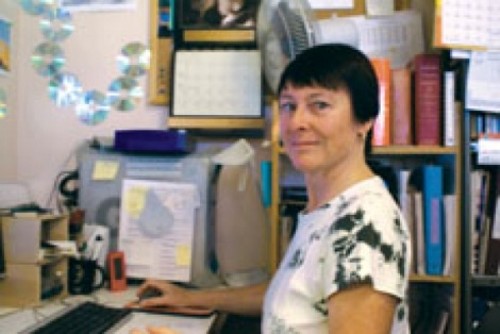News | Lactose Intolerance: Utah woman struggles to start a human milk bank for new mothers in Utah
By Eric S. Peterson @ericspetersonBernshaw heads a task force with a goal of establishing a human breast-milk bank in Utah, which would offer bottled breast milk to mothers with sick babies as an alternative to formula feeding. Bernshaw believes this project means butting heads with the well-financed interests of the baby-formula companies and their political connections.
“For as advanced as U.S. society is with technology, with military … with breastfeeding, we’re really in the backwaters,” she says.
Bernshaw is also an editor for the International Lactation Consultant Association. She had been asked in August 2006 to head a milk-bank task force, and while she has recently finished her needs assessment, she’s found resistance in the community.
“It’s like pulling teeth trying to reach anyone on this issue,” says Bernshaw, who has been trying to find grants or community donors to help set up the bank as a nonprofit. She estimates $200,000 would be needed just for operations; cost of the facility would be additional.
Bernshaw believes the investment would help low-income mothers and would cut health-care costs.
“Necrotizing Enterocolitis, or NEC, is one of three common infant diseases easily prevented by breastfeeding,” says Bernshaw “This disease costs hundreds of thousands of dollars per child [to treat]. I’m asking for $200,000 to set up the milk bank for one year. It makes you wonder why insurance companies would pay big bucks for half-solutions when nature can take care of [this] illness in a less expensive and more efficient way.”
Bernshaw points out that Utah hospitals currently use banked mothers’ milk to help treat the infant gastrointestinal problem but have it shipped from Denver—the closest milk bank to Salt Lake City.
Health-care officials agree with the merits of breast milk, and some, like Carol Lindsay, director of Women’s Services at Salt Lake City Regional Medical Center, have seen a growing demand for a bank. “There’s certainly a need,” says Lindsay. “We get mothers calling all the time to ask if they can donate their extra milk.”
The Utah milk bank Bernshaw envisions would follow the standards of the Human Milk Banking Association of North America which currently has 10 other banks in the United States and one in Canada. The bank would provide mothers with breast milk. With bottled milk at $3.50 per ounce, the price may be steep but, if mothers have a prescription, milk would be provided for next to nothing. The cost would cover screening (interview, blood and milk tests), processing and pasteurization. She imagines mothers would drop off bottles of extra milk, ship them or, in a limited capacity, donate at the bank itself.
Bernshaw expects the milk bank primarily will help mothers with sick babies, but she would also like to steer new mothers away from formula, which may be a fallback for those who are reluctant to breastfeed in public or who lack confidence in their nursing ability.
Breast milk has been scientifically proven best for infants, providing hormones, vitamin E, iron and essential fatty acids. Activists like Bernshaw consider formula not only inadequate but actually harmful to babies.
“The whole mechanism of breastfeeding is you do it or you don’t. Artificial baby milk interferes with babies’ nutrient absorption,” says Bernshaw. “It also changes the growth conditions in the intestine that makes the stools stink and causes pathogenic bacteria like E. coli to grow.”
For Bernshaw educating people about the harm of formula means confronting a multimillion-dollar baby-food industry with strong political connections to government programs that provide free formula for new mothers living on low incomes.
Bernshaw sees this most prominently in the federally funded Women and Infant Care (WIC) program. Since 1972, WIC has provided supplemental nutrition and health-care referrals to low-income women and their children. While Utah WIC advocates breastfeeding first, it also offers free formula to clients.
“On the one hand, they say breastfeeding is best, and on the other they say, ‘Here is free formula,’” says Bernshaw. “They are very dedicated [WIC staff], but they are also swamped by the formula mentality.”
Chris Furner, director of Utah WIC, understands the controversy but feels WIC’s position is to educate, offer choices and leave it up to the parent after that. “I firmly say that we promote breastfeeding first,” explains Furner, who listed myriad breastfeeding services WIC offers to new mothers. But, Furner adds, “After all the education, it’s up to the mother if they want formula.”
It is not the place of a public-assistance program to limit formula just to mothers who can’t produce their own milk, Furner says. “We can’t draw a line in the sand. We’re just a supplemental program, and for those mothers who qualify [low income] and choose not to breastfeed, we’re not going to let babies starve.”
Furner adds that WIC would not offer banked breast milk to its clients, as the agency could not verify the safety of the milk collected, even though human milk-bank standards have been approved by the American Pediatric Association and the Food and Drug Administration.
Still, Bernshaw passionately defends the natural way versus formula feeding. “As long as breast feeding is not considered the only safe way to feed your baby, it will always be under attack.”
More by Eric S. Peterson
-
The Secret Sauce
How Utah lawmakers disclose—or don't disclose—conflicts of interest.
- Feb 14, 2024
-
Police departments in Salt Lake County spent almost $20 million on civil rights complaints in the past decade
The Co$t of Mi$conduct
- Oct 18, 2023
-
Women decry harassment and toxic culture at St. George auto dealership
Men at Work
- Oct 11, 2023
- More »
Latest in News
Readers also liked…
-
Raise a glass for E.L.T Harrison, architect of the Beerhive building on Main
Small Lake City
- Oct 11, 2023





